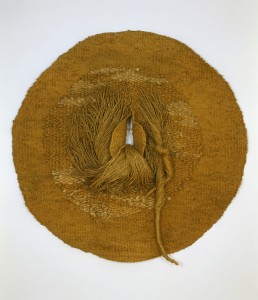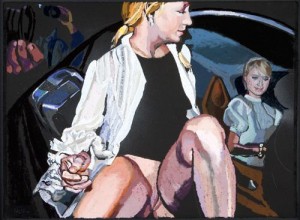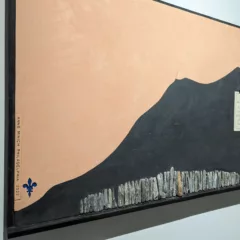Explicit views of women’s pudenda have never been in short supply in New York City but one found them on 42nd St. (before Disney arrived), not in established art galleries. Inspired by Eve Ensler’s Vagina Monologues, Francis Naumann began collecting work for an exhibition and when it grew too large, enlisted David Nolan to join him; the exhibition, The Visible Vagina, continues at both galleries through March 20. The results include the entire range of responses one might expect from women to their own most singular parts, and respectful, appreciative study by men of the most mysterious parts of women. This is an important exhibition.
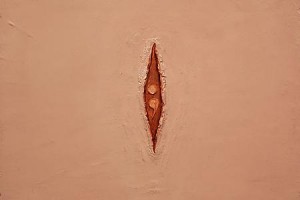
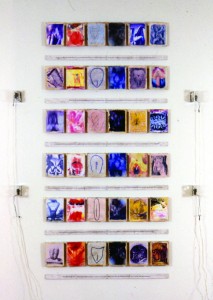
I never shared Ensler’s discomfort with the word, vagina; I was raised in a doctor’s family where all parts of the anatomy were fair game at the dinner table, as long as one used the correct term. Speaking of which, while vagina has come to be popular shorthand, the word refers to the unseen part of the female sex organs (unless one has a speculum); the external portion is the vulva or pudenda.
The most striking thing about the more than one hundred artworks is how few of them objectify women or suggest a salacious use of the imagery, other than as humorous or ironic commentary; the most egregious exception is Mark Kostabi’s large close-up of a vulva in the pallate of Las Vegas at night. The tone is rather searching, affectionate, wonderous, knowing, celebratory and humorous, with a fair number of nods to artistic precedents. The obvious and most-cited of these are Courbet’s frankly-pornographic The Origin of the World, never intended to be seen in mixed or polite company, and Duchamp’s transgressive Étant donnés, which permanently brought the imagery into the art museum. Mira Schor’s Slit of Paint (1994, above) surely respond’s to Jasper Johns’ Painting with Two Balls and Cathy de Monchaux’s I saw the past splayed with the skin of my youth (2009) to Jay de Feo’s The Rose; Allyson Mitchell’s Hungry Purse; The Vagina Dentata in Late Capitalism (2006, below) pays homage both to Faith Wilding’s Crocheted Environment (aka Womb Room) at Womanhouse and Nikki de Saint Phalle’s Hon; and I suspect that Sarah Davis’ Britany (Notorious) (2009, above), based on a famous and revealing news photo of Britany Spears makes note of Richard Hamilton’s Swinging London, itself based on a news photo of Mick Jagger attempting to hide his face.
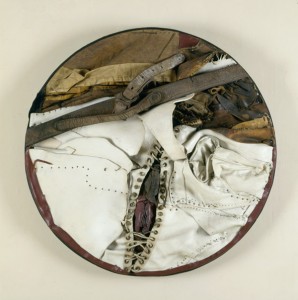
The exhibition primarily covers recent work and the period from the late 1960s-1970s, when feminism encouraged women to look at their own and each other’s sex organs; workshops were arranged for the purpose. This coincided with my own maturity and I can well-remember the frisson of transgression around such investigations. Several works date from the period (by Magdalena Abakanowicz, Nancy Grossman, Barbara Hammer, Henri Maccheroni, Ana Mendieta, Hannah Wilke, Carolee Schneemann, Robert Watts and others) but perhaps none is more closely associated with the times than Judy Chicago’s Red Flag (1971): a photograph, slightly manipulated, so it takes a moment to recognize the subject as a woman removing a bloody tampon from her vagina. Chicago’s in-your-face image of menstruation was produced against a background of ads for sanitary napkins that still showed ball-gowned women in grand settings, with the elliptical text: Modess…. because.
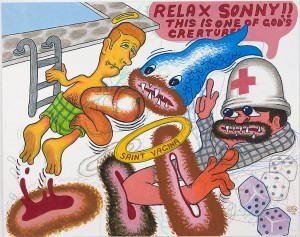
The most striking sign of how far we’ve progressed is the fact that the exhibition was arranged by men and includes male artists. Peter Saul’s drawing, Relax Sonny says it all concerning male anxiety about women’s bodies. Chuck Close’s Untitled Dauguerreotypes (2010), a diptych, is a loving study of what I assume to be the vulva of his beloved, and likely to raise no opposition. But I can’t help remembering the feminist objections (retrospective, I’d guess) to S0l LeWitt’s Muybridge I (1964), sequential photos of a nude woman as the facing camera moves closer and, focusing on her belly-button, includes ever closer views of her crotch. Is it just the times that make the Close acceptable, or is our tolerance based on the misconception that sixty year old men (Close or Picasso) can do nothing but look?
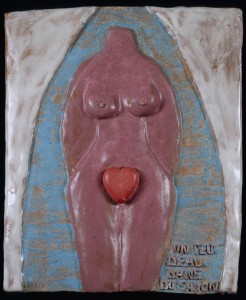
I’ve always been fascinated by what can and can’t be shown and The Visible Vagina raises the question again and again. The earliest work is Beatrice Wood’s small clay relief, Un peut d’eau dans du savon (1917, shown in a replica of 1977), a woman’s body in the bath with a heart-shaped piece of carved soap functioning as a fig-leaf. I suspect that the charming image could appear on a Hallmark greeting card these days, but Naumann told me that when included in the 1917 exhibition of the Society of Independent Artists (which rejected Duchamp’s Fountain), it provoked a scandalized reaction and extensive press; Wood told of daily having to remove calling-cards that men had left in the frame.
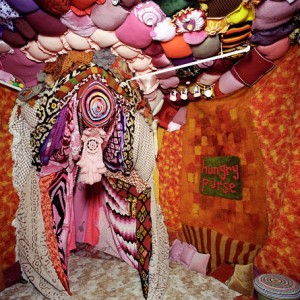
Each of the galleries includes and installation that visitors can enter. Allyson Mitchell’s wonderful and hilarious Hungry Purse; The Vagina Dentata in Late Capitalism at Nolan is a lair formed primarily of riotously-polychrome crochet of the sort recycled by Mike Kelly. The large clitoris above the entry is discretely shielded as one enters by a fringed g-string and the throne opposite is decorated with owls — Athena’s, no doubt. Pendant cages house chipmunks (squirrels?), one of which is visibly lactating. At Naumann Carol Cole’s equally humorous Back into the Womb uses a pup-tent as armature for what reads as the skirt of a ball-gown of beige tulle over red satin, until the anatomical reference becomes clear. Visitors can put their heads through the aperture where a handy flashlight is provided to illuminate the roof, decorated with baby pacifiers and nipples, and the floor, covered with red-sprayed egg-crate foam; certainly the most imaginative use of the material I know, although the referent was open for discussion.
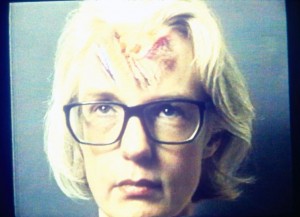
The installation at Nolan had a few delightful surprises: next to the entrance are two images by Mel Kendrick of bark on a tree, done in ink on Japanese paper. The aperture on each is so subtle that one might believe he intended them as knots on the tree trunks. In the second space the surprise is the pairing; I saw Judie Bamber’s astonishingly-lifelike, narrow close-up of a woman’s pudenda – surely a photograph, beside Beth B.’s delicate, pencil drawing of an equally-narrow view of pudenda and anus. Or that’s what I thought I saw, for the Bamber is a tromp l’oel oil on panel, while Beth B.’ is a photo. Close by is Maureen Connor’s wonderfully-deadpan video, Heads, from The Sixth Sense in which a woman’s thoughts are recorded on her forehead; as she puts on make up she fantasizes she’s Grace Kelly, then when she see’s a young Cary Grant and Paul Newman, she’s fingering her clitoris.
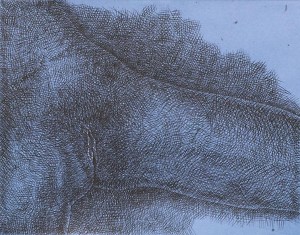
The exhibition is accompanied by a 124 pg. catalog (The Visible Vagina, ISBN 978-0-98-00556-3-4) with extensive color photographs of many of the works on view and comparative material, and an essay by Anna C. Chave, ‘Is this good for Vulva?’; Female Genetalia in Contemporary Art. Chave introduces the contemporary work with a history of pre-historic fertility figures that emphasize the vulva, and the man-made narrative that artistic generation is exclusive to men (human generation being unequivocally women’s work). She traces the artistic emphasis on mother goddesses and generative forms during the early days of feminism then looks at the dialectic of woman’s body as site of knowledge versus the concern that emphasizing the body is essentializing. Chave situates the development of feminist art within changing social, legal and cultural currents and looks at several artists from backgrounds beyond the U.S. and Europe. The catalog gives a unique presentation of several generations of women who use their most private anatomy as a subject for art.
All proceeds from the catalog sales will be donated to V-Day, the organization Eve Ensler founded to end violence against women. It would make a wonderful Valentine’s Day gift!
The Visible Vagina coincides with another New York exhibition based upon vaginal imagery, Ida Applebroog; MONALISA at Hauser and Wirth, which will be the subject of my next post.
